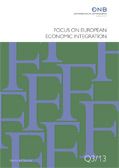Focus on European Economic Integration Q4/20
 OeNB
OeNB
- published:
- December 2020
 OeNB
OeNB
Call for applications: Klaus Liebscher Economic Research Scholarship (PDF, 73 kB) en Dec 2, 2020, 12:00:00 AM
Developments in selected CESEE countries (PDF, 1.1 MB) Coronavirus sends CESEE region into a deep recession1 en Dec 2, 2020, 12:00:00 AM
Outlook for selected CESEE countries (PDF, 287 kB) CESEE-6: deepest downturn after transformational recession, uncertain recovery; Russia: economy expected to recover gradually en Dec 2, 2020, 12:00:00 AM
What drives people’s expectations of euro adoption? – Evidence from the OeNB Euro Survey on selected CESEE countries (PDF, 750 kB) Backé, Beckmann. Recently, the monetary integration of some countries in Central, Eastern and Southeastern Europe (CESEE) has gained new momentum. Based on data from the OeNB Euro Survey from 2007 to 2019, we present evidence on individuals’ expectations regarding accession to the euro area and examine how the framework that governs euro area accession, the different monetary policy regimes and de facto euroization affect expectations. We find that expectations have become less optimistic over time and that individuals’ uncertainty in forming expectations has increased. Exposure to de facto euroization increases optimism in expectations regarding euro introduction and decreases uncertainty. Individuals who trust their national central bank and the EU expect accession to the euro area to take place sooner. Expectations of inflation or depreciation of the local currency are related to more pessimistic expectations regarding euro introduction. Monetary expectations (i.e. inflation and exchange rate expectations) play a stronger role for EU member states than for EU candidates and potential candidates; regarding trust in institutions the picture is reversed. en euro area accession, expectations, uncertainty, CESEE D12, D84, E50, O52 Dec 2, 2020, 12:00:00 AM
Macroprudential policy in the Western Balkans: the last five years and COVID-19 crisis response (PDF, 320 kB) Barisitz, Hildebrandt. This study takes stock of macroprudential policy instruments and their recent development (since 2015) in Western Balkan3 economies. Banks in the region, which are dominated by institutions headquartered in the EU, tend to be in good shape, profitable and well capitalized. All countries under review are oriented toward EU macroprudential policies, given that they strive to join the European Union. However, the pace at which the required policy frameworks are being put into place differs across countries. Preparatory work for the creation of large parts or entire macroprudential and prudential toolkits is still ongoing in Kosovo and Montenegro, while Serbia and North Macedonia have already accumulated some experience in using related instruments (including capital buffers, reserve requirements, risk weights, etc.). Albania and Bosnia and Herzegovina are situated somewhere in between these two groups of economies in terms of the range and the timing of measures put in place. The biggest remaining challenges include elevated growth rates of partly unsecured consumer loans, and still high shares of foreign currency loans in total loans – notwithstanding de-euroization measures. The COVID-19 crisis triggered the immediate relaxation of some macroprudential measures and regulatory standards. Yet, the bulk of COVID-19 response steps is situated outside the macroprudential realm and includes moratoria on loan repayments, adjustments in loan classification and provisioning rules, which in turn, may (temporarily) undermine the economic substance of capital buffers. en banking sector, financial stability, macroprudential policy, Western Balkans F34, F36, G21, G28 Dec 2, 2020, 12:00:00 AM
86th East Jour Fixe: All about COVID-19? Geopolitical, economic and macrofinancial perspectives for the Western Balkans (PDF, 126 kB) en Dec 2, 2020, 12:00:00 AM
Statistical annex (PDF, 189 kB) en Dec 2, 2020, 12:00:00 AM